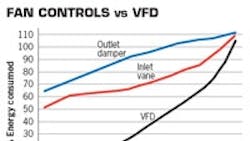There are well-known benefits of using variable-frequency drives (VFDs) to reduce energy consumed by induction motors. Federal, state and local agencies in the U.S. now all give incentives for installing VFDs, as do many utilities. The energy saved by using VFDs can be compelling, and taking advantage of these programs can add considerably to their savings.
To briefly review, VFDs are electronic controls that manage three-phase ac electric motor speed. By regulating speed, a VFD assures that a motor dissipates only the amount of energy needed to handle the instantaneous load. The alternative to VFDs in most ac motor applications is a single-speed motor consuming its fully rated nameplate power regardless of what the application needs. Throttling is often handled with clutching or braking.
For example, many commercial and industrial building HVAC systems use single-speed ac motors to run fans. The fan air is controlled by an inlet vane or an outlet damper. A better alternative is to replace the vane or damper with a VFD that continuously regulates motor speed.
All three approaches consume about the same amount of energy at 100% air flow. But at reduced air needs, the VFD approach uses much less energy. When an HVAC system demands 50% of air flow, tests have shown that a VFD uses 21% of unrestricted full-flow energy. At the same 50% flow, inlet vane control would use 65% of full-flow energy and outlet damper control would consume 87% of full-flow energy.
Differences are even more pronounced at low air flows. At 20% of air flow, a VFD design only consumes 5% of full-flow energy. By contrast, an inlet vane system would use 51% and an outlet damper would use 64% of full-flow energy. A calculation engine that generates energy savings at various levels of flow can be found at http://bit.ly/4hN8ip.
Besides saving energy, VFD control reduces maintenance costs and extends operating life by letting a motor run at less than its fully-rated speed when possible. Finally, VFDs allow more precise control of air flow, increasing comfort for building occupants.
Buildings account for more than a third of U.S. energy use, so they are an important target for energy efficiency improvements. Research by the American Society of Heating, Refrigeration and Air-Conditioning Engineers shows that approximately 50% on all energy used in a typical building goes into HVAC operation. Using VFDs to reduce HVAC energy consumption can thus result in significant energy savings, and the payback on investment can be substantial.
Even without rebates, payback periods for installing VFDs are usually less than three years and sometimes can be less than a year. Rebate programs can reduce payback periods to a matter of months. The Database of State Incentives for Renewables & Efficiency (www.dsireusa.org) is one resource that offers comprehensive information on federal, state, local and utility incentives that promote renewable energy and energy efficiency.
States often lead the way in adopting progressive policies promoting energy efficiency. Many states offer incentives for energy efficiency upgrades that include a direct rebate payment due upon installation. The federal government also offers tax deductions or credits for attaining defined levels of efficiency or for supporting specific energy-saving technologies, and many states do as well.
Rebate levels vary widely within the U.S., but the American Council for an Energy Efficient Economy (ACEEE) estimates that rebates usually cover from 15 to 35% of installed cost. However, the ACEEE warns that utility and government-funded rebates are not guaranteed. Such rebates often depend on the accessibility of funding and are often doled out based on a competitive ranking system. Because of the energy market's volatility, the ACEEE suggests applying for rebates in the planning stages of construction or upgrades, but to keep potential rebates out of the installation budget.
Although each utility can have its own variations, rebate programs generally contain similar standard features. For example, Austin Energy (www.austinenergy.com) offers rebates of 20% for qualified VFD use in HVAC applications. These levels are typical of those available from other utilities.
ENERGY CONSUMED AS A PERCENTAGE OF UNRESTRICTED FULL-FLOW ENERGY CONSUMPTION
DIFFERENT FAN FLOW CONTROLS
VFDs really show their worth in air moving applications that sometimes only use a small percentage of total available air flow.
Resources
American Council for an Energy Efficient Economy, www.ACEEE.org
Austin Energy, www.austinenergy.com
Yaskawa Electric VFD calculator, http://bit.ly/4hN8ip
Database of State Incentives for Renewables & Efficiency, www.dsireusa.org
